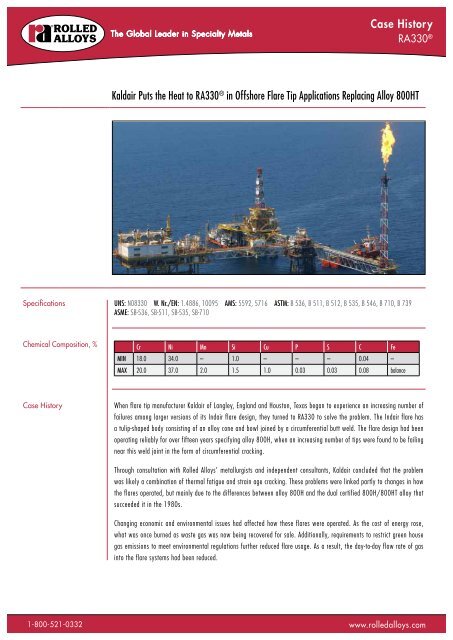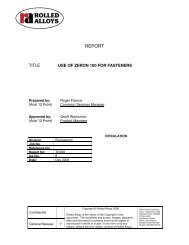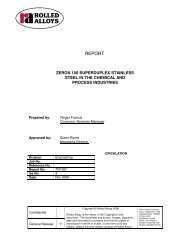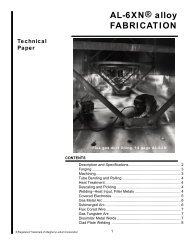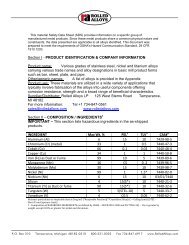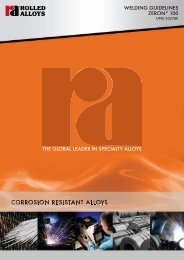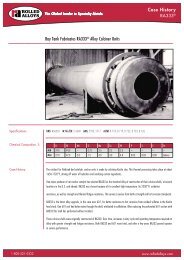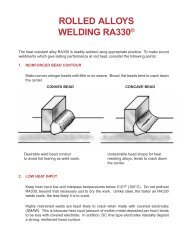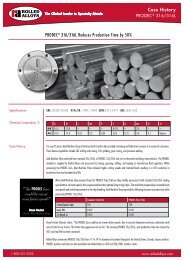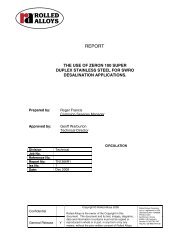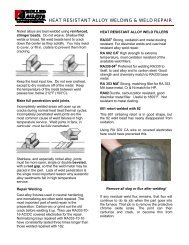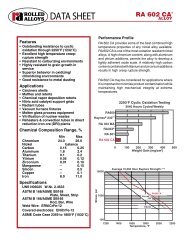RA330 Flare Tips - Rolled Alloys
RA330 Flare Tips - Rolled Alloys
RA330 Flare Tips - Rolled Alloys
Create successful ePaper yourself
Turn your PDF publications into a flip-book with our unique Google optimized e-Paper software.
The Global Leader in Specialty Metals<br />
Case History<br />
<strong>RA330</strong> ®<br />
Kaldair Puts the Heat to <strong>RA330</strong> ® in Offshore <strong>Flare</strong> Tip Applications Replacing Alloy 800HT<br />
Specifications UNS: N08330 W. Nr./EN: 1.4886, 10095 AMS: 5592, 5716 ASTM: B 536, B 511, B 512, B 535, B 546, B 710, B 739<br />
ASME: SB-536, SB-511, SB-535, SB-710<br />
Chemical Composition, % Cr Ni Mn Si Cu P S C Fe<br />
MIN 18.0 34.0 – 1.0 – – – 0.04 –<br />
MAX 20.0 37.0 2.0 1.5 1.0 0.03 0.03 0.08 balance<br />
Case History<br />
When flare tip manufacturer Kaldair of Langley, England and Houston, Texas began to experience an increasing number of<br />
failures among larger versions of its Indair flare design, they turned to <strong>RA330</strong> to solve the problem. The Indair flare has<br />
a tulip-shaped body consisting of an alloy cone and bowl joined by a circumferential butt weld. The flare design had been<br />
operating reliably for over fifteen years specifying alloy 800H, when an increasing number of tips were found to be failing<br />
near this weld joint in the form of circumferential cracking.<br />
Through consultation with <strong>Rolled</strong> <strong>Alloys</strong>’ metallurgists and independent consultants, Kaldair concluded that the problem<br />
was likely a combination of thermal fatigue and strain age cracking. These problems were linked partly to changes in how<br />
the flares operated, but mainly due to the differences between alloy 800H and the dual certified 800H/800HT alloy that<br />
succeeded it in the 1980s.<br />
Changing economic and environmental issues had affected how these flares were operated. As the cost of energy rose,<br />
what was once burned as waste gas was now being recovered for sale. Additionally, requirements to restrict green house<br />
gas emissions to meet environmental regulations further reduced flare usage. As a result, the day-to-day flow rate of gas<br />
into the flare systems had been reduced.<br />
1-800-521-0332<br />
www.rolledalloys.com
1-800-521-0332<br />
www.rolledalloys.com<br />
Case History, Continued<br />
It would seem logical to think that decreased time at full flow and less burning would be beneficial to flare life. As it turns out,<br />
the opposite is true. The changes in operation led to more intermittent use of the flares and more cyclical conditions. A flare<br />
system must be capable of handling sudden surges in flow during emergency conditions. In the Indair design, the flame burns<br />
radially out of the neck of the flare and wraps around the outer curves of the flare body. As the flame burns, it pulls cooler air into<br />
the flame surrounding the flare. This actually has a quenching effect on the flare tip during periods of high gas flow.<br />
During relatively low flow conditions, metal temperatures of the flare are estimated to be between 1112-1382°F. The temperature<br />
itself is relatively mild for heat resisting alloys. In this case, it was not the heat itself that caused the failure. Rather, it was the<br />
rapid cycling to lower temperatures during surges in gas flow. These thermal cycles resulted in thermal shock and cracking of the<br />
800HT alloys. Cyclic conditions were intensified by environmental factors such as wind and rain contacting the flare.<br />
The 800HT alloys is designed for high creep-rupture strength at elevated temperatures. This strength is largely a result of solution<br />
annealing to a coarse grain structure (ASTM 5 or coarser) and alloying with aluminum and titanium. Large grains, while beneficial<br />
to creep-rupture strength, are detrimental to resisting thermal fatigue cracking under cyclic conditions. The combined aluminum<br />
and titanium levels of 800HT are higher than the original 800H alloy. As a result, 800HT can precipitate sufficient levels of<br />
gamma prime phase to cause strain age cracking. Gamma prime precipitation is most pronounced during operation in the vicinity<br />
of 1200°F, which is consistent with the estimated operating temperatures for the Indair flare design.<br />
In considering new alloys for the application, several requirements were identified. The alloy needed to be produced to a finer grain<br />
size than 800HT for thermal fatigue resistance. The alloy needed to be resistant to the effects of strain aging. The alloy needed to be<br />
weldable to itself with a matching filler to avoid undue stresses created by differential thermal expansion. The alloy needed to resist<br />
corrosion in the difficult conditions under which the flare operates. Finally, the alloy needed to be priced similarly to 800HT alloy.<br />
What alloy was found to meet all of these requirements? <strong>RA330</strong> alloy. <strong>RA330</strong> alloy is annealed to produce a moderate grain size.<br />
The result is an alloy with good creep rupture strength and excellent resistance to thermal fatigue. Since <strong>RA330</strong> has a moderate<br />
chromium content and no Al or Ti additions, <strong>RA330</strong> does not age or embrittle due to the precipitations of intermetallic compounds,<br />
such as gamma prime or sigma phase, during exposure to intermediate temperatures, 1000-1600°F. <strong>RA330</strong> is welded to itself<br />
using <strong>RA330</strong>-04 weld filler. Lastly, <strong>RA330</strong> is capable of withstanding extended exposure to temperatures up to 2100°F and is<br />
priced competitively with alloy 800HT.<br />
<strong>RA330</strong> alloy has now been used successfully for the Indair flare design for over 5 years. At this time, it has been substituted for<br />
most flare applications that had been using the 800HT alloy.<br />
<strong>RA330</strong> is a registered trademark of <strong>Rolled</strong> <strong>Alloys</strong><br />
The Global Leader in Specialty Metals<br />
www.rolledalloys.com<br />
© 2011 <strong>Rolled</strong> <strong>Alloys</strong><br />
Bulletin No. 2030USe 10/11<br />
The data and information in this printed matter are believed to be reliable. However, this material is not intended as a substitute for competent professional engineering assistance which is a requisite to any specific application. <strong>Rolled</strong> <strong>Alloys</strong> makes no<br />
warranty and assumes no legal liability or responsibility for results to be obtained in any particular situation, and shall not be liable for any direct, indirect, special, or consequential damage therefrom. This material is subject to revision without prior notice.


